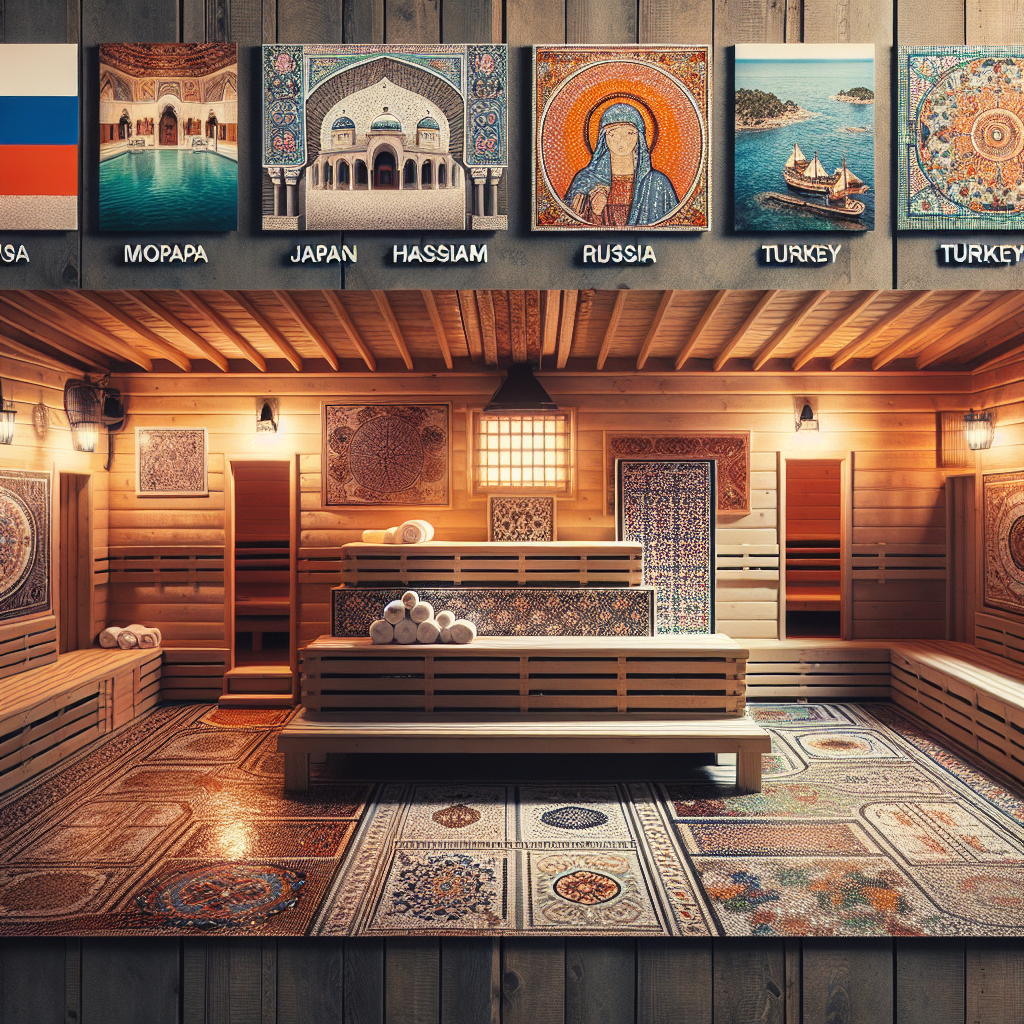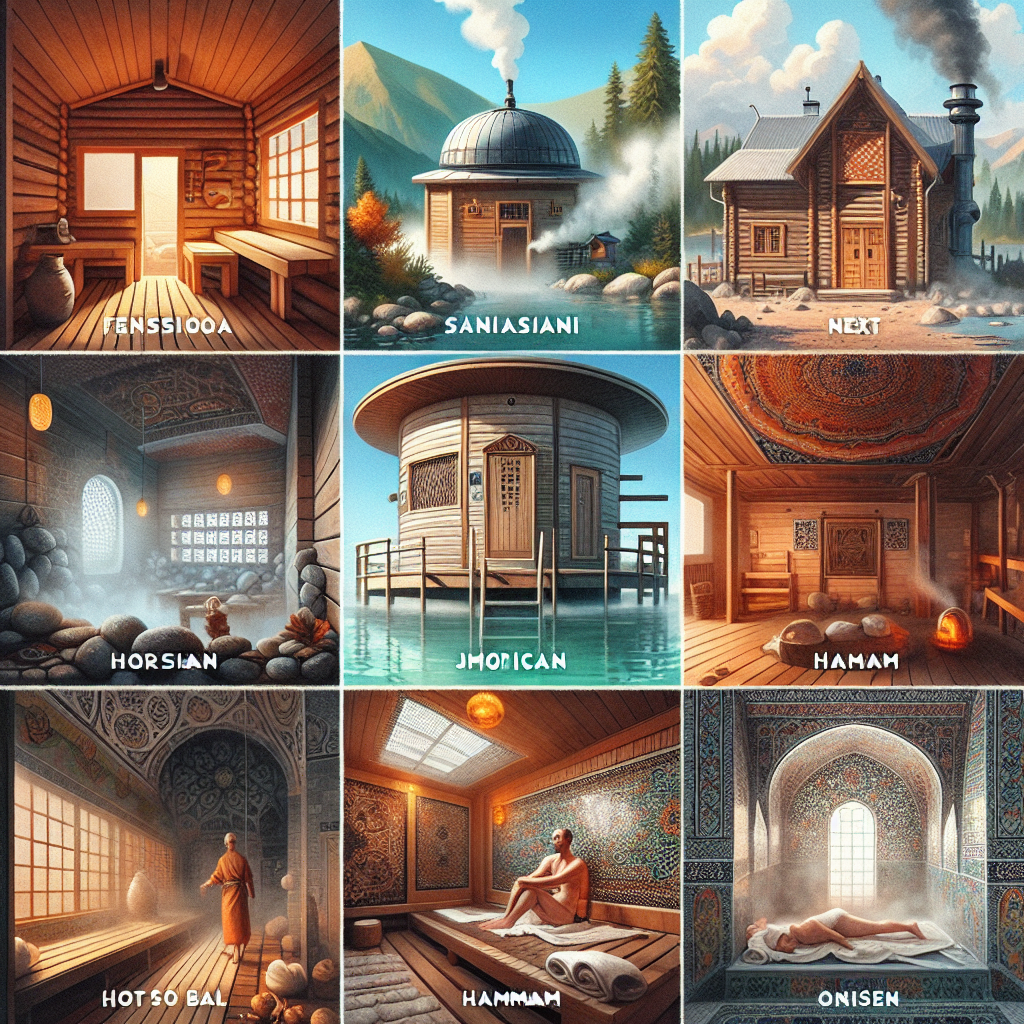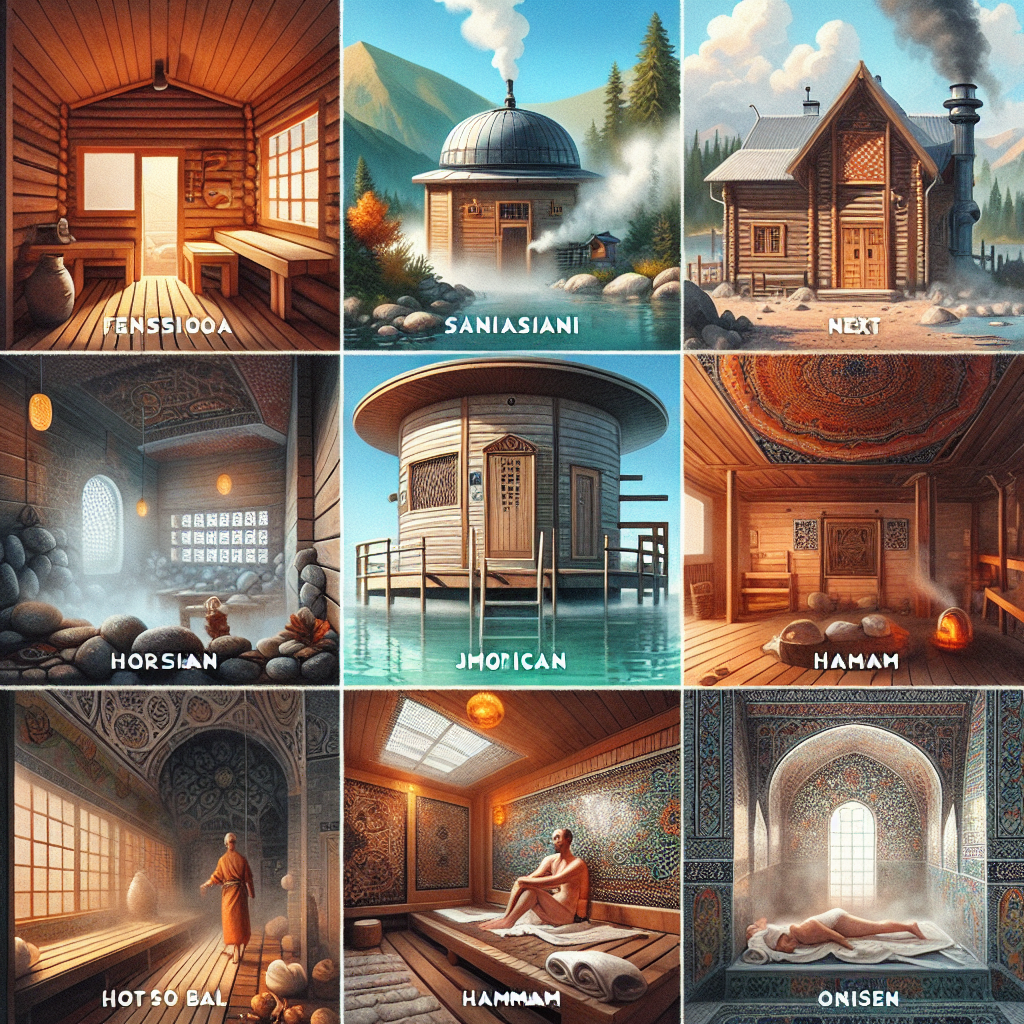Picture this: you’re sitting in a cozy wooden room, enveloped by a wave of soothing warmth. The air is thick with steam, and beads of perspiration gently roll down your forehead. This is a sauna, a cultural phenomenon that stretches across the globe, captivating people from all walks of life. But have you ever wondered just how saunas fit into different cultures around the world? From Finland’s revered sauna rituals to Japan’s traditional bathhouses, join us as we embark on a journey to explore the multifaceted ways in which saunas are woven into the tapestry of various cultures.
Saunas in Finland
Traditional Finnish Saunas
In Finland, saunas are deeply rooted in the country’s culture and have been a significant part of Finnish life for centuries. Traditional Finnish saunas are known for their unique design and rituals. They are typically small wooden cottages or rooms made of spruce or pine and are heated by a wood-burning stove, known as a kiuas. The sauna experience involves heating the room to high temperatures, usually between 70 and 100 degrees Celsius, and then pouring water on the hot stones to produce steam. This creates a dry, hot, and relaxing environment.
Sauna Etiquette in Finland
In Finland, sauna etiquette is an important aspect of the sauna culture. When visiting a Finnish sauna, it is customary to shower before entering the sauna to ensure cleanliness. It is also common practice to enter the sauna completely naked, as clothing would hinder the experience. The sauna is a place of relaxation, so it is important to maintain a calm and quiet atmosphere. It is considered impolite to have loud conversations or engage in disruptive behavior. It is customary to sit on a wooden bench and enjoy the heat while occasionally taking breaks to cool down and hydrate.
Public Saunas in Finland
Finland is famous for its public saunas, which are an integral part of Finnish society. They can be found in various places, including lakesides, swimming pools, hotels, and even public parks. Many public saunas offer separate sections for men and women, while others have designated times for each gender. Public saunas are a social gathering place for friends, families, and even strangers. It is common to see people enjoying the sauna together and engaging in conversations, creating a sense of community and relaxation.
Saunas in Russia
Banya – Russian Sauna
In Russia, saunas are known as banyas and have been a part of the country’s culture for centuries. Banyas are traditionally built with log walls and feature a large oven called a pechka, which is heated with firewood. The temperature inside a banya can reach up to 80 degrees Celsius. Russian saunas also incorporate a unique element called a Venik, which is a bundle of birch or oak branches used for beating the body. This practice is believed to improve blood circulation and provide a rejuvenating effect.
Banya Rituals and Traditions
Banyas in Russia are not only a place for relaxation but also a cultural and social institution. It is common for family and friends to gather in a banya to celebrate special occasions or simply enjoy each other’s company. Banya rituals often involve steam sessions followed by a dip in cold water or a roll in the snow, known as “okhlazhdeniye,” which is believed to invigorate the body. In addition to this, it is customary to have tea and snacks in between sauna sessions to replenish energy.
Modern Saunas in Russia
While traditional banyas still hold significant importance in Russian culture, modern saunas have also emerged in the country. These modern saunas often feature additional amenities such as pools, jacuzzis, and massage services. They cater to a wider range of preferences and provide a more contemporary sauna experience. However, traditional banyas continue to thrive, as they offer a sense of authenticity and cultural heritage that cannot be replicated.

Saunas in Japan
Onsen and Sento – Japanese Bathhouses
In Japan, saunas are primarily represented by two types of bathhouses – onsen and sento. Onsen refers to natural hot springs, while sento refers to public bathhouses that use heated water. These bathhouses hold great significance in Japanese culture and are seen as places of relaxation and purification. Onsen, in particular, are known for their therapeutic properties due to the mineral content in the spring water.
History of Japanese Bathing Culture
The history of Japanese bathing culture dates back centuries. The practice of communal bathing in Japan can be traced to religious and spiritual beliefs, as well as the desire for cleanliness and purification. Bathing in onsens and sentos is not only a physical experience but also a spiritual one. It is seen as a way to cleanse both the body and the soul, providing relaxation and rejuvenation.
Onsen Etiquette
In Japanese onsens and sentos, there are specific customs and rules to follow. Before entering the bathing area, it is customary to thoroughly clean and rinse your body. Many onsens and sentos require complete nudity, while some may have separate sections for men and women. It is important to be respectful of others and not engage in loud conversations or disruptive behavior. Additionally, it is common to bring a small towel into the bath area to cover private parts or to use as a seat cushion.
Saunas in Korea
Jjimjilbang – Korean Sauna
In Korea, saunas are commonly referred to as jjimjilbangs and are an essential part of Korean culture. Jjimjilbangs are not just places for relaxation but also social hubs. They are known for their various sauna rooms, which are heated at different temperatures and infused with natural elements such as minerals, salt, and charcoal. Jjimjilbangs also offer a range of amenities, including rest areas, massage services, and even sleeping areas.
Health Benefits of Jjimjilbang
Visiting jjimjilbangs is considered a holistic approach to wellness in Korea. The different sauna rooms in a jjimjilbang are believed to offer various health benefits. For example, the salt room is thought to improve respiratory health, while the charcoal room is believed to detoxify the body. The practice of alternating between hot and cold rooms is believed to improve blood circulation and boost the immune system.
Jjimjilbang Etiquette
When visiting a jjimjilbang, it is important to follow proper etiquette. Like other saunas, complete nudity is the norm in gender-segregated areas. However, some jjimjilbangs offer alternate clothing options for those who may be uncomfortable with nudity. It is common to bring a small towel for drying off and for sitting on. Conversations should be kept at a low volume to maintain a relaxing atmosphere. Jjimjilbangs are also popular overnight destinations, allowing visitors to take breaks, rest, and even sleep in designated areas.

Saunas in Sweden
Swedish Saunas and Culture
In Sweden, saunas, known as bastu, have been a vital part of the culture for centuries. Swedish saunas are typically made of wood and heated using an electric or wood-burning stove. The temperature inside a Swedish sauna usually ranges from 70 to 100 degrees Celsius. Saunas in Sweden are not limited to private spaces; they can be found in public places such as sports facilities, hotels, and even on ferries.
Sauna Traditions and Rituals in Sweden
Swedish sauna traditions focus on the concept of relaxation and simplicity. Sauna sessions often involve sitting on wooden benches and enjoying the heat, followed by cooling off in the cold air or by taking a dip in a nearby lake or sea. Swedish saunas encourage a slow and mindful approach, allowing individuals to unwind and relieve stress. Sauna rituals in Sweden are also often accompanied by socializing, where friends and family gather to enjoy the sauna together.
Modern Sauna Culture in Sweden
In recent years, Swedish sauna culture has evolved to incorporate modern amenities. Many public saunas in Sweden now offer additional features such as music, lighting effects, and even saunas with panoramic views. These contemporary saunas aim to enhance the overall sauna experience and attract a younger audience. Despite the modern additions, traditional Swedish saunas continue to thrive, providing a connection to nature and a sense of simplicity.
Saunas in Native American Cultures
Sweat Lodge Ceremonies
In Native American cultures, saunas are represented by sweat lodge ceremonies. Sweat lodges are sacred structures used for ceremonial purposes, healing, and spiritual growth. They are typically made of bent willow branches or stones covered with animal hides, blankets, or tarps to create a small, domed structure. The interior is heated by pouring water on hot stones, generating steam and a meditative environment.
Spiritual Significance of Sweat Lodge
Sweat lodge ceremonies hold deep spiritual significance for Native American communities. They are seen as a way to connect with the natural world, the spirit realm, and the community. The heat and steam inside the sweat lodge symbolize a purifying experience, allowing participants to cleanse their bodies, minds, and spirits. Sweat lodge ceremonies often involve prayers, songs, and sharing of stories, creating a space for reflection, healing, and personal growth.
Traditional Native American Sauna Practices
Native American sauna practices vary among tribes, but they often involve similar principles and intentions. Sweatlodge ceremonies are led by a designated spiritual leader who guides the participants through the experience. The rituals and protocols followed during these ceremonies are highly respected and treated with reverence. Participants are encouraged to enter the sweat lodge with humility, respect, and an open mind, allowing the experience to be transformative and healing.
Saunas in Turkey
Hammam – Turkish Bath
In Turkey, saunas are known as hammams and are an integral part of Turkish culture and history. Hammams are bathhouses that combine elements of sauna, bathing, and massage. These ornate spaces are adorned with intricate tiles and marble, creating a luxurious and relaxing atmosphere. Hammams typically consist of several rooms, including a hot room, a warm room, and a cool room.
Hammam Rituals and Customs
Hammam rituals in Turkey involve a traditional bathing experience that follows a specific sequence. Visitors start by entering the hot room to relax and sweat, then move to the warm room for an exfoliating scrub using a coarse mitt called a kese. Following the scrub, visitors are washed with soap and warm water in the warm room. The experience concludes with a cool room, where visitors can rest and cool down.
Modern Hammams
While traditional hammams continue to thrive in Turkey, modern versions have also emerged. Modern hammams often offer additional services such as facials, massages, and beauty treatments. These modern hammams cater to a wider audience, providing a more spa-like experience. However, traditional hammams remain popular, as they offer a unique cultural experience and a journey into the past.
Saunas in South Africa
Sweat Therapy in South Africa
In South Africa, saunas are used as a form of sweat therapy. Sweating is believed to have various health benefits, such as detoxification, stress relief, and improved circulation. South African sweat therapy involves a combination of sauna sessions, massage, and herbal remedies. It is seen as a holistic approach to wellness and rejuvenation.
Traditional African Steam Baths
Traditional African steam baths, known as “isishweshwe,” have been practiced for generations. These steam baths involve sitting over a fire or hot stones covered with medicinal herbs, creating steam. Participants sit on woven mats or blankets, allowing the steam to envelop their bodies. This practice is often accompanied by chanting, singing, and storytelling, creating a communal and healing atmosphere.
South African Healing Ceremonies
Sweat therapy in South Africa is often integrated into healing ceremonies and rituals. These ceremonies draw upon traditional African beliefs and practices, incorporating elements such as drumming, dancing, and chanting. The intention is to provide physical, emotional, and spiritual healing. These healing ceremonies are often facilitated by traditional healers or sangomas, who hold deep ancestral knowledge and wisdom.
Saunas in Norway
Norwegian Saunas and Culture
In Norway, saunas, known as badstue, have a significant presence in the culture. Saunas in Norway are typically found in private homes, cabins, or sports facilities. They are commonly made of wood and heated using an electric stove or sauna rocks. Norwegian saunas typically have a lower temperature compared to Finnish saunas, ranging from 60 to 80 degrees Celsius, making it a more moderate sauna experience.
Sauna Customs and Traditions in Norway
Norwegian sauna customs emphasize relaxation and time spent in nature. It is common for Norwegians to have saunas in conjunction with a dip in a nearby lake or sea to cool down and invigorate the body. Sauna rituals often involve alternating between heat and cold, allowing individuals to reap the benefits of contrast therapy. Sauna sessions in Norway are also seen as a way to unwind and create a sense of mental and physical well-being.
Modern Sauna Experiences in Norway
In recent years, modern sauna experiences have gained popularity in Norway. From floating saunas on lakes to unique sauna designs, Norwegians have embraced innovation while maintaining a strong connection to nature. Some modern saunas incorporate glass walls, offering panoramic views of the surrounding landscapes. This blending of traditional and modern elements showcases Norway’s commitment to preserving its sauna culture while incorporating contemporary touches.
Saunas in Native Canadian Cultures
Inipi – Indigenous Sweat Lodge
In Native Canadian cultures, saunas are represented by the inipi, also known as the sweat lodge. The inipi is a ceremonial structure made of willow branches, blankets, and animal hides, similar to sweat lodges in Native American cultures. The inipi is used for purification, prayer, and spiritual connection. It is seen as a sacred space where individuals can release negative energy, seek spiritual guidance, and connect with higher powers.
Inipi Ceremonies and Practices
Inipi ceremonies vary among Native Canadian tribes, but they often involve similar practices. Participants are guided by a designated spiritual leader who leads prayers, chants, and songs. Inside the inipi, hot stones are placed in a pit in the center, and water is poured over them to produce steam. Participants sit in a circle, often naked or wrapped in blankets, to create a sense of unity and equality. The ceremony may include periods of silence, sharing of stories, and individual reflections.
Spiritual and Healing Aspects of Inipi
The inipi holds deep spiritual and healing significance for Native Canadian cultures. The heat and steam inside the sweat lodge are believed to cleanse the body, mind, and spirit. Inipi ceremonies are seen as a way to seek guidance, offer prayers, and promote spiritual growth. The experience of sweating and purifying is seen as transformative and can lead to personal insights, emotional release, and a deeper connection with the natural and spiritual world.
In conclusion, saunas are not simply places to relax and unwind; they hold immense cultural, spiritual, and social significance in various countries around the world. From the traditional Finnish saunas that have become a way of life, to the spiritual sweat lodge ceremonies of Native American cultures, each sauna experience offers a unique glimpse into the customs, traditions, and values of the respective cultures. Whether it be the healing properties believed in Japan’s onsens or the communal gatherings in Russian banyas, saunas provide a space for rejuvenation, connection, and reflection, transcending mere physical relaxation. So, next time you step into a sauna, remember that you are participating in a rich and diverse global tradition that spans across continents and generations.

